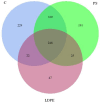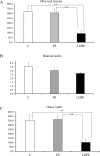The impact of co-fed plastic diet on Tenebrio molitor gut bacterial community structure
- PMID: 40594024
- PMCID: PMC12217557
- DOI: 10.1038/s41598-025-04805-8
The impact of co-fed plastic diet on Tenebrio molitor gut bacterial community structure
Abstract
This study aimed to analyze the long-term impact of co-fed plastic diet on the bacterial community of self-sustaining laboratory populations of T. molitor fed with wheat bran with added polystyrene (PS), and low density polyethylene (LDPE) over a three year period. The most abundant phyla for all three populations were Firmicutes, Bacteroidota and Proteobacteria. PS group microbiota is similar to C group, pointing to a common bacterial species capable for degrading lignocellulose and PS, while consumption of LDPE caused a significant decrease of Bacteroidota and Actinobacteriota compared to both C and PS group, and Campylobacterota compared to PS group. A predictive metabolomics analysis recognized dTDP-L-rhamnose biosynthesis I in PS group as one of five unique pathways, while other five distinctive pathways, like peptidoglycan maturation, were linked to LDPE group. Further studies are needed to determine the plastic degrading properties of the detected bacteria. The results highlight T. molitor's versatility in biotechnological applications.
© 2025. The Author(s).
Conflict of interest statement
Declarations. Competing interests: The authors declare no competing interests. Ethics approval: All animal procedures were in compliance with Directive 2010/63/EU on the protection of animals used for experimental and other scientific purposes and were approved by the Ethical Committee for the Use of Laboratory Animals of the Institute for Biological Research “Siniša Stanković,” National Institute of the Republic of Serbia, University of Belgrade.
Figures






Similar articles
-
Microbial communities associated with plastic fishing nets: diversity, potentially pathogenic and hydrocarbon degrading bacteria.Sci Rep. 2025 Jul 2;15(1):22877. doi: 10.1038/s41598-025-06033-6. Sci Rep. 2025. PMID: 40594211 Free PMC article.
-
Response of the yellow mealworm (Tenebrio molitor) gut microbiome to diet shifts during polystyrene and polyethylene biodegradation.J Hazard Mater. 2021 Aug 15;416:126222. doi: 10.1016/j.jhazmat.2021.126222. Epub 2021 May 26. J Hazard Mater. 2021. PMID: 34492977
-
Response patterns and community assembly processes of gut microbiota in grass carp subjected to various protein sources and their implications for growth and metabolism.Fish Physiol Biochem. 2025 Apr 16;51(3):83. doi: 10.1007/s10695-025-01498-8. Fish Physiol Biochem. 2025. PMID: 40238018
-
Interventions for the management of abdominal pain in Crohn's disease and inflammatory bowel disease.Cochrane Database Syst Rev. 2021 Nov 29;11(11):CD013531. doi: 10.1002/14651858.CD013531.pub2. Cochrane Database Syst Rev. 2021. PMID: 34844288 Free PMC article.
-
Psychological and/or educational interventions for the prevention of depression in children and adolescents.Cochrane Database Syst Rev. 2004;(1):CD003380. doi: 10.1002/14651858.CD003380.pub2. Cochrane Database Syst Rev. 2004. Update in: Cochrane Database Syst Rev. 2011 Dec 07;(12):CD003380. doi: 10.1002/14651858.CD003380.pub3. PMID: 14974014 Updated.
References
-
- United Nation Environmental Program (UNEP). Single-use plastics: A roadmap for sustainability | UNEP - UN Environment Programme, 6. (2018).
-
- Ksenia, J. G. et al. Overview of known plastic packaging-associated chemicals and their hazards. STOTEN651, 3253–3268 (2019). - PubMed
-
- Turner, A. Foamed polystyrene in the marine environment: sources, additives, transport, behavior and impacts. Environ. Sci. Technol.54, 10411–10420 (2020). - PubMed
-
- Kik, K., Bukowska, B. & Sicinska, P. Polystyrene nanoparticles: Sources, occurrence in the environment, distribution in tissues, accumulation and toxicity to various organisms. Environ. Pollut.262, 114297 (2020). - PubMed
-
- Ergut, A., Levendis, Y. A. & Carlson, J. Emissions from the combustion of polystyrene, styrene and ethylbenzene under diverse conditions. Fuel86, 1789–1799 (2007).
MeSH terms
Substances
Grants and funding
LinkOut - more resources
Full Text Sources

